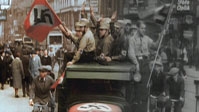Monetizing archives

The film industry has perfected to a science the maximization of revenue of its movie libraries. Initially, revenue is generated through a release timeline that schedules the various market releases: theatrical, pay, rental, airline, home, etc. Intertwined with that release schedule is domestic vs. foreign release. The timeline formula is constantly revisited and carefully honed as a function of entertainment value and market forces in an attempt to assure that for any given film, the maximum in revenue is extracted from each of the release windows.
Once that occurs and the film becomes part of the library, revenue generation continues in the form of rerelease. The film industry enjoys its own version of Moore's Law: As technology has spawned new distribution media and viewing devices, the film industry has enjoyed the revenue generated initially from release of VHS to rerelease to DVD and now to Blu-ray and iTunes.
Broadcast takes a cue
Is the broadcast industry now reading the Hollywood script? Discovery Channel UK has launched a series titled “World War II.” This wartime series is comprised of original footage that has been restored, colorized and upconverted to HD. In a project conceived by media company IMG and produced by Nugus Martin Productions (NMP) in London, the 13-week series of hour-long episodes debuted in the UK in early September and in France later that month. Initial ratings show that it has been well received.
The colorizing of the original black-and-white material was done with relentless attention to detail. This happened in part by forming a team whose job it was to ensure that uniforms, ships, tanks and planes were colorized accurately and correctly for that era. NMP reviewed massive amounts of archival footage before finally narrowing down to the 650 minutes of program content ultimately selected for colorization and HD upconversion. Footage came from Germany, Japan and the United States, which further complicated matters as differing frame rates provided a challenge in the digitization process of the footage.
Creatively, it was decided that the key to telling the story and to holding the attention of today's audience was to not overwhelm the viewer with narrative. As a result, there is plenty of space between commentary, allowing effects and the footage to speak for itself. This was no small feat because most of the footage was silent, thereby requiring the painstaking recreation of sound effects.
The key decision was who could transform the film into the visual impact required for the content experience envisioned by the producers. Enter West Wing Studios. With experience in high-resolution colorization and restoration projects ranging from “The Three Stooges” to music videos and feature-length films, West Wing Studios applied its technical and creative prowess to the project. Michael Southard, head of the project for West Wing Studios, was challenged with delivering the restored, colorized and upconverted content. And, that challenge was a significant one in that some of the episodes consisted of a potpourri of scenes from entirely different sources, with varying frame rates, differing film stock and condition ranging from fair to poor to severely damaged.
The professional video industry's #1 source for news, trends and product and tech information. Sign up below.
There were many poignant aspects to this project, but one in particular is best summarized in Southard's words to me. He says, “There were also some emotionally difficult scenes. The West Wing animators in India handled that in their unique way — separating the shots of the death camps and handing them out to the most experienced animators. These shots were then done meticulously, with each person, [or body] in individual clothing and skin tones. The reason was one of respect for the Holocaust victims, and was very important to our production staff.”
The broadcaster — in this era of the seemingly impossible: constant pressures on reducing costs and increasing profits while trying to maintain an audience that continues to be fractionalized by the eyeball war of competing media — must remember, it's all about content. There are hundreds of thousands of hours of content in the broadcasters' archives. Are you monetizing yours?
Anthony R. Gargano is a consultant and former industry executive.
Send questions and comments to:anthony.gargano@penton.com
